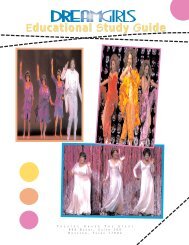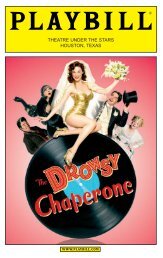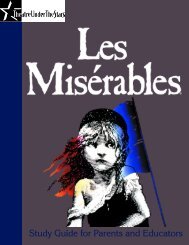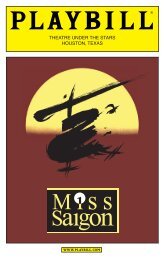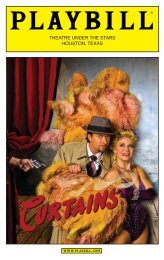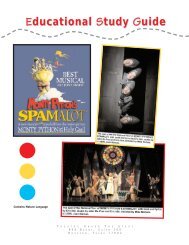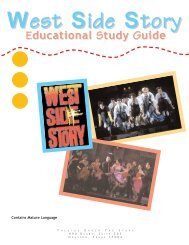THEATRE UNDER THE STARS HOUSTON, TEXAS
THEATRE UNDER THE STARS HOUSTON, TEXAS
THEATRE UNDER THE STARS HOUSTON, TEXAS
Create successful ePaper yourself
Turn your PDF publications into a flip-book with our unique Google optimized e-Paper software.
A NOTE FROM <strong>THE</strong> SCENIC DESIGNER<br />
When TUTS got the opportunity to produce our own version of<br />
the modern classic musical blockbuster Les Misérables, the<br />
original producers had a stipulation that initial scenic designer<br />
John Napier’s landmark “revolving barricade” scenery should be<br />
reserved for their own ongoing touring and resident productions<br />
in New York or London. TUTS had a chance to try something<br />
new, and below are scenic designer Matthew Kinley's thoughts<br />
on the subject.<br />
I had already worked on several original productions of Les<br />
Misérables with John Napier when I was asked to start looking<br />
at another version for this tour. The task was a daunting one as<br />
John's original set is undoubtedly one of the masterpieces of<br />
20th century theatre design, and despite its size there is very<br />
little fat to be cut from it, which presented me with a problem.<br />
The angle I wanted to explore with Fred Hanson was releasing<br />
the design from the black brick box it had been in for the past 22<br />
years, as the one thing the original show doesn't quite<br />
communicate is any sense of time or place.<br />
Photos courtesy of Theater of the Stars – Atlanta © Joan Marcus 2008<br />
folded paper with ink (similar to Rorschach tests) as well as<br />
straight responses to either landscape, figure or the<br />
subconscious.<br />
The one unifying feature throughout his whole body of work is<br />
the somber yet beautiful mainly sepia color palette, and<br />
especially his use of chiaroscuro - using the contrast of dark<br />
and light to add both body and form as well as atmosphere to<br />
the work. This brooding blackness and light also seemed the<br />
perfect embodiment of so many characters and storylines within<br />
the show.<br />
I knew I wanted to work with projection in order to locate the<br />
action, but to be used very simply, almost more like old<br />
fashioned slides as this was a show whose story was so<br />
complex it didn't justify constant animation apart from some key<br />
scenes. The question was: what to project?<br />
I had been vaguely aware that Victor Hugo was a painter as well<br />
as a writer, but nothing quite prepared me for the images which<br />
I came across when researching the show. Hugo was obviously<br />
a visionary; the drawings I found were at once both abstract,<br />
fantastical and free but underlined with a backbone of<br />
draftsmanship. Hugo as an artist was well ahead of his time;<br />
there are many examples in amongst the 4000 or so works<br />
which demonstrate his experiments with different media and<br />
processes; from charcoal, sepia, pen, ink and soot to lace prints,<br />
It was for this reason that I started to employ the use of these<br />
paintings in the projections as they were so dark and rich I<br />
thought they would live well within the original aesthetic of the<br />
show. Many of the projections are produced using a blend of his<br />
paintings and drawings sometimes combined with 19th century<br />
French photography to ground and locate them, combined with<br />
painted cloths which are more directly based on his abstract<br />
work.<br />
Hugo kept his paintings and drawings away from public<br />
exhibition for fear they may detract from his writing. Delacroix<br />
expressed the opinion that if Hugo had decided to become a<br />
painter instead of a writer, he would have outshone the artists of<br />
their century. Indeed, there are many paintings which would not<br />
have looked out of place within the works of the credited<br />
abstract expressionists and surrealists in the following century. I<br />
hope that this production can go some way to reconciling these<br />
two aspects of this artist with each other, as to me they seem to<br />
have a perfect symmetery.<br />
Matthew Kinley<br />
Guest Scenic Designer, Les Misérables



